The journey to color e-readers has been a long one, starting with the Ectaco jetBook Color back in 2011. It was groundbreaking then, but the technology took nearly a decade to catch on with consumers. Now, things have changed. Color e-ink is here, and it’s finally delivering on the promise of vibrant, full-color reading on e-paper.
In this article, I’ll examine the four best color e-readers that won’t break the bank. Let’s dive in and see which ones are worth considering!
The Quick List
| Top Pick | Kobo Libra Colour | Check Price |
| Best Android Color E-reader | Onyx Boox Go Color 7 | Check Price |
| Best Ergonomic | Pocketbook Era Color | Check Price |
| Best Budget | Kobo Clara Colour | Check Price |
Specs Comparison
| Specs | Kobo Clara Colour | Onyx Boox Go Color 7 | Pocketbook Era Color | Kobo libra Colour |
| Display | 6″ Kaleido 3 | 7” Kaleido 3 | 7” Kaleido 3 | 7” Kaleido 3 |
| CPU | Dual Core 2.0 GHz | Octa-core 2.4Ghz (Snapdragon 665) | Quad Core (1.8 GHz) | Dual Core 2.0 GHz |
| RAM & ROM | 1GB+16GB | 4GB+64GB | 1GB+32GB | 1GB+32GB |
| Battery | 1500 mAh | 2300mAh | 2500 mAh | 2050 mAh |
| Buttons | N/A | Available | Available | Available |
| Stylus Compatibility | Not compatible with Kobo Stylus | N/A | N/A | Kobo Stylus |
| Waterproof | IPX8 | N/A | IPX8 | IPX8 |
| OS | Kobo firmware | Android 12 | Linux 4.9.56 | Kobo firmware |
| Weight | 174g/6.14oz | 195g/6.9oz | 235g/8.29oz | 199.5g/7.04oz |
Top 4 Budget-Friendly Color E-Readers
1. Kobo Clara Colour
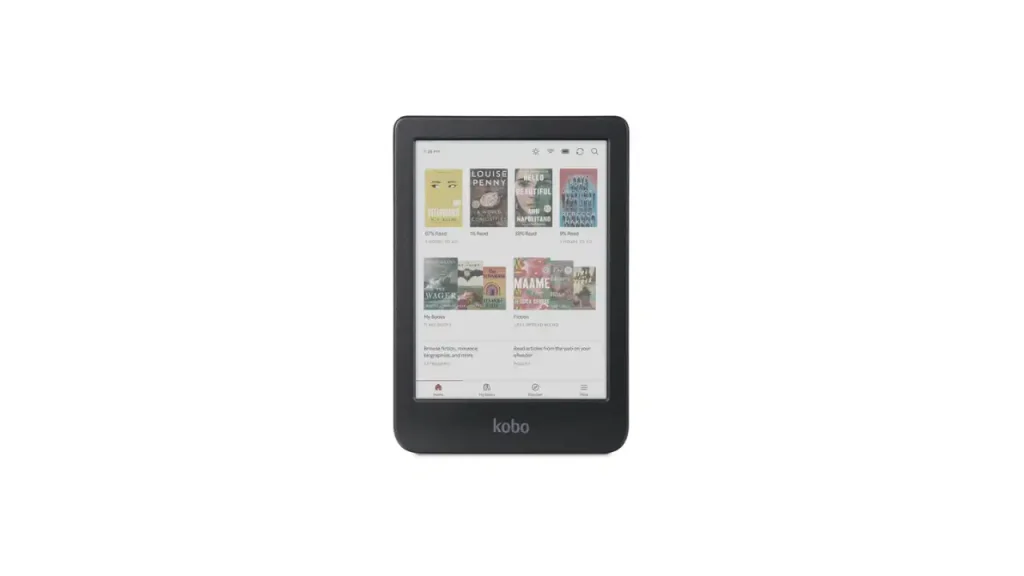
The Kobo Clara Colour is an excellent entry-level device for those curious about color e-readers. Its compact and lightweight design makes it easy to carry around and read on the go.
The device features a 6″ Kaleido 3 screen, which, though smaller than some competitors, offers a vibrant reading experience. While the color display isn’t as vibrant as a tablet, it strikes a good balance between color reproduction and the eye-friendly nature of E Ink. However, the smaller screen size may not be ideal for extensive reading sessions or for those who prefer larger displays.
One of the big perks of the Clara Color is its integration with OverDrive, which lets you easily borrow books from your local library. Plus, you get access to millions of ebooks through Kobo’s ecosystem, and the Kobo Plus subscription gives you unlimited reading for a monthly fee.
A downside, though, is the lack of wireless file transfers via Google Drive or Dropbox, a feature found in the Kobo Libra Color. It’s not a dealbreaker, but it’s something to remember.
While it might not have all the premium features of higher-end models, the Kobo Clara Color is a solid, affordable choice for anyone wanting to dip their toes into the world of color eReaders. I just wish the screen was a little bigger for a more immersive feel.
Reasons to Buy
+Affordable and ideal for those new to color e-readers.
+Compact and lightweight, making it easy to carry and read on the go.
+Seamlessly borrow books from local libraries via OverDrive integration.
Reasons to Avoid
-The smaller screen size may not be ideal for extended reading sessions.
-Lacks Google Drive or Dropbox file transfer support, unlike other models.
2. Onyx Boox Go Color 7
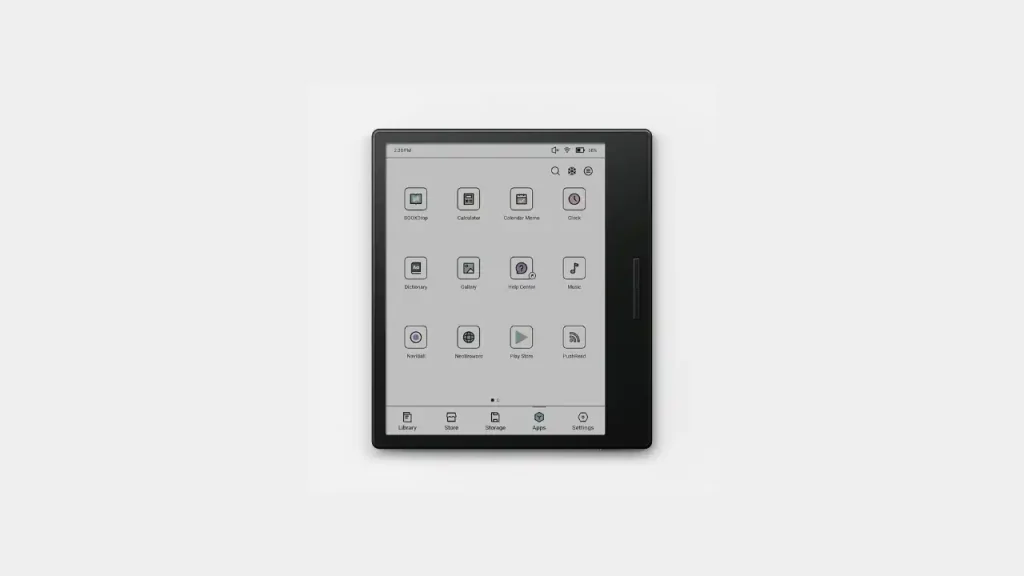
The Onyx Boox Go Color 7 is a mid-range option that offers the best of both worlds: a 7″ Kaleido 3 display and the flexibility of Android 12.
It features an asymmetrical design with a grip area and physical buttons on the side of the screen. Proper hardware buttons mean the device offers more flexibility in use. In terms of weight, the Go Color 7 is almost identical to the Kobo Libra Color, officially weighing 195 g.
It has improved the back cover design. The textured surface is much better than the fingerprint-prone backs of previous models and provides a more secure grip. Overall, the device feels very sturdy, with no creaks or cracks.
The device features a 7-inch E-Ink Kaleido 3 display with 300 black-and-white and 150 PPI color resolutions. It uses a color filter on top of the black-and-white screen to generate colors, allowing it to display up to 4,096 colors. While the color saturation isn’t as vibrant as an iPad, it’s still good enough for most users, especially for reading magazines, manga, and art books. Just one complaint is that you need to turn on the front light at least 50% to be able to read in a dark room because the screen is dark/ gray compared to non-color e-readers.
The primary drawback is the screen’s graininess and muted colors, which are inherent in E-Ink technology. Still, it’s perfectly usable once you adjust to it. The front light, while not the brightest (maxing out at 17 nits), is evenly distributed and sufficient for most everyday use. The color temperature can be adjusted between cool white and warm orange, which is a nice touch.
Regarding specs, the Boox Go Color 7 is a powerhouse. It features an octa-core Snapdragon 665 CPU, 4GB of RAM, and 64GB of internal storage. The device runs a customized version of Android 12, designed specifically for the E-Ink display. The performance is excellent thanks to the octa-core CPU. The ability to install apps from the Google Play Store means you’re not limited to a single ecosystem. You can read books from Kindle, Kobo, Nook, and more all on one device. This flexibility is a major selling point for many users.
The library interface is clean and easy to navigate, with options to sync files across cloud services like Google Drive or Dropbox. The Neo reader is being optimized for the device and performs quite fine! It features everything you need and, even better, can be used to open ebooks downloaded from any site. You can customize the text style, font size, and margins to your liking, offering a more refined experience than previous Boox models. Boox also provides a decent text-to-speech feature, using Android’s built-in voice synthesis to read eBooks aloud.
Nevertheless, there are a few minor drawbacks:
1.The button design is seamless. It looks nice, but without a gap between them, it isn’t easy to use without looking.
2.The power button is located at the bottom. This can be annoying if the device is lying flat, as even a slight bump can trigger it.
3.There is no support for Wacom pens, so you’re limited to the capacitive touchscreen for input.
Overall, the Boox Go Color 7 is an excellent color eReader. The color saturation is as good as it gets for E-Ink, and the front light is evenly distributed. The build quality is solid, and Android expandability is a huge plus. However, the device has a steeper learning curve than other eReaders like the Kindle or Kobo, but once you get the hang of it, it’s capable and versatile.
Reasons to Buy
+7’’ Kaleido 3 display provides a larger and more vibrant reading experience.
+Flexible Android 12 OS allows you to install apps from multiple ecosystems like Kindle, Kobo, and Nook.
+High-end specs include a Snapdragon CPU, 4GB RAM, and 64GB storage.
+Customizable reading experience with adjustable text style, font size, and margins.
More ergonomic, with easy-to-use physical buttons.
Reasons to Avoid
-Requires at least 50% front light in darker environments.
-Steep learning curve; can be harder to use compared to Kindle or Kobo.
3. Pocketbook Era Color
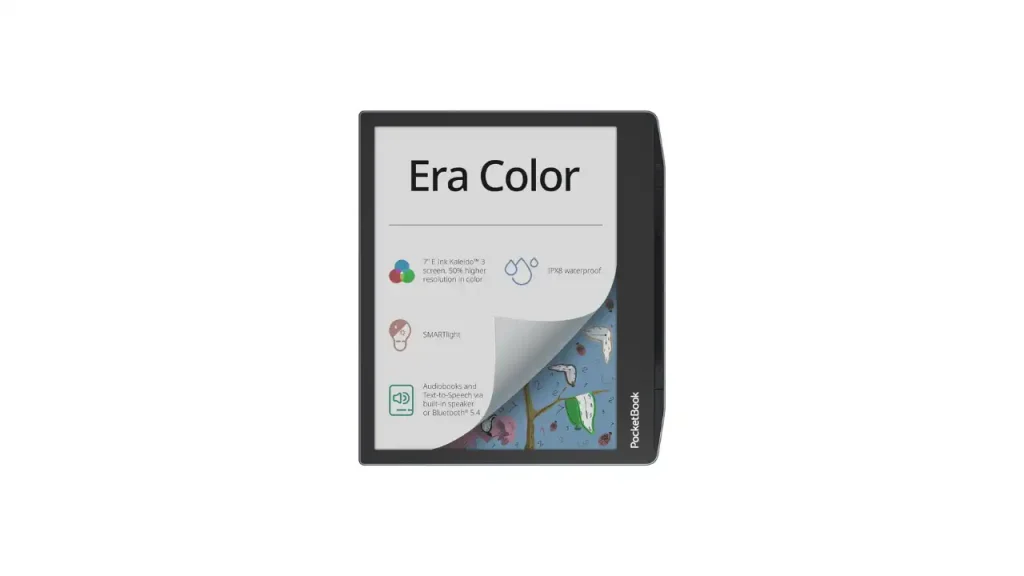
The major selling point of Pocketbook Era Color is undoubtedly its sleek form factor. The asymmetrical design, with a comfortable grip area on one side, makes it a pleasure to hold for long reading sessions. At first glance, the angled bezels might seem purely aesthetic, but they actually offer an ergonomic advantage, allowing for a more natural hand position. The buttons are conveniently placed along the bezel, although I wish they were a bit more tactile, similar to the ones found on PocketBook’s InkPad series. The flush and scratch-resistant front glass is a first for PocketBook’s color e-readers, giving it a modern and premium feel.
As a Color E-Reader, the PocketBook Era Color is a solid option. While the colors may not be as vibrant as on a tablet, the 7-inch E-Ink Kaleido 3 screen, which offers 150 PPI for color, ensures a comfortable reading experience that’s easy on the eyes. Like other Kaleido 3 screens, it is darker than a typical black-and-white E-Ink display, but PocketBook has optimized the settings for better readability. I’d recommend tweaking the default settings for even more vibrant colors. The screen works great in bright sunlight without needing the front light, but indoors, you might need to set the light to around 25%, even in a well-lit room.
Ghosting is minimal when reading text but more noticeable when viewing images. Thankfully, you can reduce this by setting the screen to refresh with every page turn.
The reading experience on PocketBook Era is perfect. The device performs quite well while reading standard eBooks, PDFs, or comics. With a wide range of font customization options, text-to-speech functionality, and access to multiple dictionaries, the device makes reading accessible and enjoyable. One downside is that it doesn’t support Audible due to restrictions, but you can still load your audio files. The built-in speaker is decent, though you might prefer using Bluetooth headphones for better audio quality.
One thing to note: the PocketBook Era Color doesn’t have dedicated stylus support, but you can take notes using your fingers. It’s not as responsive as a stylus-equipped device like the Remarkable, but it’s a nice feature to have nonetheless.
The PocketBook Era Color also lets you purchase books through Google Books in the United States. It features a service similar to Kindle’s “Send to Kindle,” which works seamlessly. Syncing content across devices is easy with PocketBook’s Cloud service and app, allowing you to access your books on your phone or tablet.
While the battery life isn’t groundbreaking, it’s respectable for a color display device. The front light does drain the battery, but you’ll still get about 11 hours of usage with brightness set to 100% and page refresh intervals of 15 seconds.
With a solid build, customizable software, 32GB of storage, wireless charging support (via an optional case), 5GHz WiFi, a 2,500mAh battery, and IPX8 water resistance, the PocketBook Era Color is a strong contender in the color E-Ink niche. If you’re looking for a feature-rich color e-reader with great ergonomics, the PocketBook Era Color is definitely worth considering.
Reasons to Buy
+Sleek, ergonomic design with a comfortable grip for long reading sessions.
+Scratch-resistant front glass adds a premium feel and protects the display.
+Ideal for reading various content, including PDFs and comics.
+Strong ecosystem support with cloud sync, Google Books integration, and compatibility with Kindle’s “send to Kindle” feature.
+IPX8 rating for added durability.
Reasons to Avoid
-Muted color vibrancy may not meet expectations.
-No stylus support: while you can take notes with your fingers, it lacks dedicated stylus functionality.
4. Kobo Libra Colour
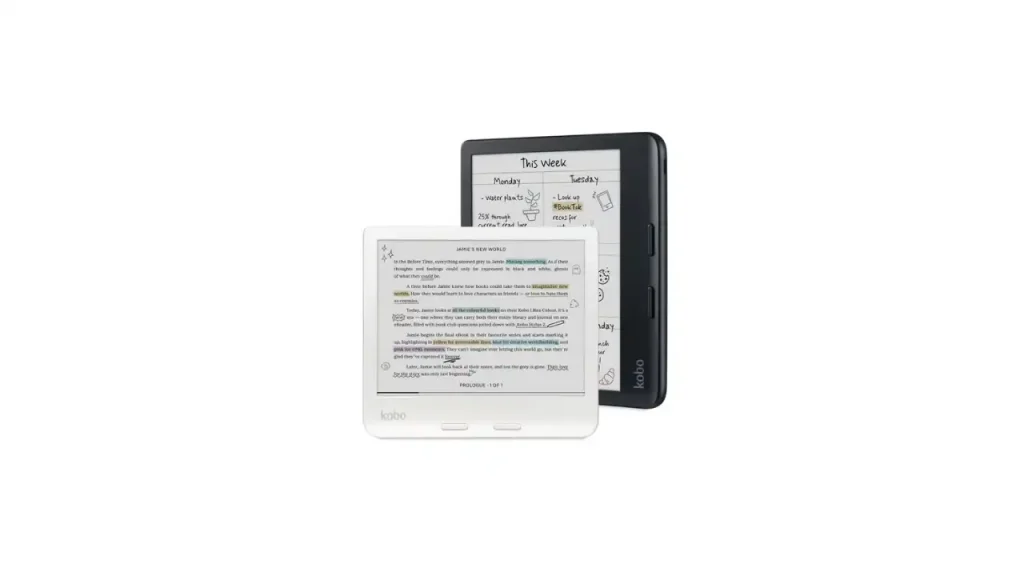
The Kobo Libra Colour takes everything great about the Clara Colour and elevates it to the next level. The larger 7-inch display provides a more immersive reading experience. While the price might seem steep, it comes with some great features.
The 7″ E Ink Kaleido 3 display is fantastic for black-and-white text, giving you crisp 300 ppi clarity. While the color resolution is lower at 150 ppi, it’s still great for reading comics and magazines. The colors come through as pastel-like, making them gentle on the eyes.
What I really like about the Kobo Libra Colour is its asymmetrical design. The asymmetrical design means it’s heavier on one side than the other, so you tend to switch hands far more often due to the off-centered weight. However, it is comfortable for me, and since the device is lightweight, my hands don’t get tired easily, so I’m not constantly switching hands.
The physical page-turn buttons are also a great addition, especially for one-handed reading. And if you’re someone who switches hands a lot, the auto-rotating screen makes that super easy. The buttons even remap themselves, so you’re never fumbling around.
The ComfortLight PRO is another big win. You can adjust the warmth of the light, making it ideal for reading in any setting—whether bright daylight or nighttime. And since it’s waterproof (IPX8, up to 60 minutes in 2 meters of water), you won’t have to worry about bringing it to the beach or pool.
The battery life for my use case is 20 to 22 hours per charge (front light brightness of 50 nits), which is roughly the same for the Kobo Clara. So battery life isn’t a factor either since that is based on uses. If you read with 0% brightness, your battery will last longer. But if you run with brightness constantly on 50+, your battery will be short no matter which device you use.
One of the standout features of the Libra Colour is its compatibility with the Kobo Stylus 2. The stylus is accurate and responsive, though there’s a tiny delay when you start writing. It’s minor but worth noting, especially since the Notebooks feature can feel a bit sluggish.
As with all Kobo devices, the Libra Colour works seamlessly with Kobo’s ebook store and the Kobo Plus subscription. You also get a built-in OverDrive for easy borrowing from your local library, which adds a lot of value for keen readers.
On the whole, the Kobo Libra Colour is a great all-around e-reader. It’s comfortable, feature-packed, and perfect for anyone looking for a color e-reader with physical page-turning buttons and note-taking abilities.
Reasons to Buy
+Larger 7-inch Kaleido 3 display offers a more immersive experience, perfect for comics and magazines.
+ComfortLight PRO provides adjustable warm and cool light settings for different environments.
+Asymmetrical design with physical buttons makes it ideal for one-handed reading with an auto-rotating screen.
+Compatible with the Kobo Stylus 2 for note-taking and annotation.
Reasons to Avoid
-The asymmetrical design (heavier on one side) may lead to frequent hand-switching, which some may find uncomfortable over time.
-Higher price point, more expensive compared to other options.
7 Key Factors to Consider When Choosing a Color E-Reader
Now that we’ve explored some of the top options, let’s break down the key factors you should consider when choosing a color e-reader:
1.E Ink Kaleido 3 or E Ink Gallery 3
Display quality is one of the most important factors when choosing a color e-reader. Two leading technologies in color e-ink screens are E Ink Kaleido 3 and E Ink Gallery 3.
Color e-ink typically has a resolution of 150 PPI, which is decent but not as sharp as the 300 PPI seen in black-and-white e-ink. This disparity can make text and image sharpness noticeably different depending on the level of detail required.
Additionally, e-ink displays are limited to approximately 4,096 colors, so precise color reproduction may not always be accurate. Despite this limitation, Kaleido 3 does an impressive job of masking its color constraints, offering a visually appealing experience. It also offers vibrant color reproduction and faster response times, though it can be more expensive and may exhibit ghosting effects.
Gallery 3, on the other hand, excels with high-resolution color images at 300 PPI but suffers from slower response times and potentially more ghosting while being significantly costlier.
Consider e-readers featuring advanced e-ink technology like Kaleido 3 or Gallery 3 for optimal color reproduction and reduced ghosting. However, there aren’t many devices with Gallery 3 available right now. Hopefully, we will see more devices with the upgraded Gallery 3 this year.
2.Screen Size
Color e-readers are great for comics and magazines. They provide an immersive experience, especially when the screen is large. However, you may need to sacrifice portability. Consider at least a 10-inch color e-reader if portability is not an issue.
3.Ecosystem Compatibility
As of September 2024, Kindle has no color e-reader options. So, if you have an extensive Kindle library or Kindle Unlimited subscription, your best bet is an Android-based e-reader like the Boox Go Color 7 or Bigme inkNoteX Color.
Android-based e-readers allow you to install multiple reading apps, giving you access to books from Kindle, Kobo, Nook, and more. Boox and Bigme both make color e-ink tablets that run on an Android operating system and can use the Kindle app.
However, if you prefer a more streamlined experience and are happy with a single ecosystem, devices like the Kobo Libra Color or a potential future color Kindle might be more up your alley.
4.Battery Life
One of the most significant advantages of e-readers over tablets is their impressive battery life. However, color displays consume more power than black-and-white ones. Color e-readers require higher brightness settings to make colors pop, which can impact battery life. When choosing a color e-reader, look for devices that offer at least a week of regular use on a single charge.
5.Note-Taking Capabilities
If you’re a student, researcher, or just someone who likes to jot down thoughts while reading, consider a device with good note-taking capabilities. Look for color e-readers that support stylus input and offer features like handwriting recognition.
The Kobo Libra Color, for instance, works well with the Kobo Stylus 2. Annotating is easy, and the official Kobo Stylus 2 works well when paired with the device. It’s responsive and accurate.
6.Software and Updates
The software experience can make or break a color e-reader. Look for devices from companies with a track record of regular software updates and improvements. Kobo and Onyx Boox, for example, are known for their frequent updates that often add new features and refinements.
7.Price
Color e-readers are generally more expensive than their black-and-white counterparts. Decide on your budget before starting your search. Remember that while Android-based devices like the Bigme Inknotex Color are pricier, they offer more functionality and might replace the need for a separate tablet. There are also budget-friendly options that provide excellent value for money.
Pros And Cons Of Color E-Readers
| Pros | Cons |
|---|---|
| The most significant advantage is the ability to show colors, which enhances the user experience, especially for comics and magazines. | The RGB layer used in color e-ink technology (specifically Kaleido 3) makes the screen appear darker, especially when the front light is not used. |
| Color e-readers can be helpful for activities beyond reading eBooks, such as browsing websites, reading emails, or engaging in other tasks that benefit from color displays. | Color e-readers often display text with lower resolution and sharpness, typically offering 150 DPI for color compared to 300 DPI for black-and-white displays. This can lead to a less crisp reading experience. |
| Like traditional e-ink displays, color e-ink screens work well in direct sunlight, improving visibility compared to LCD screens. | Compared to black and white ebook readers, Color e-readers typically require more power to operate. |
| Color e-readers can display book covers in color, which is more visually appealing and similar to physical books. | Colors on current color e-ink devices are muted or “pastel-like” compared to tablets or smartphones, lacking the vibrancy of LCD screens. |
| Color e-readers are suitable for both text-based books and color content like comics and magazines. |
Recommended Readings!

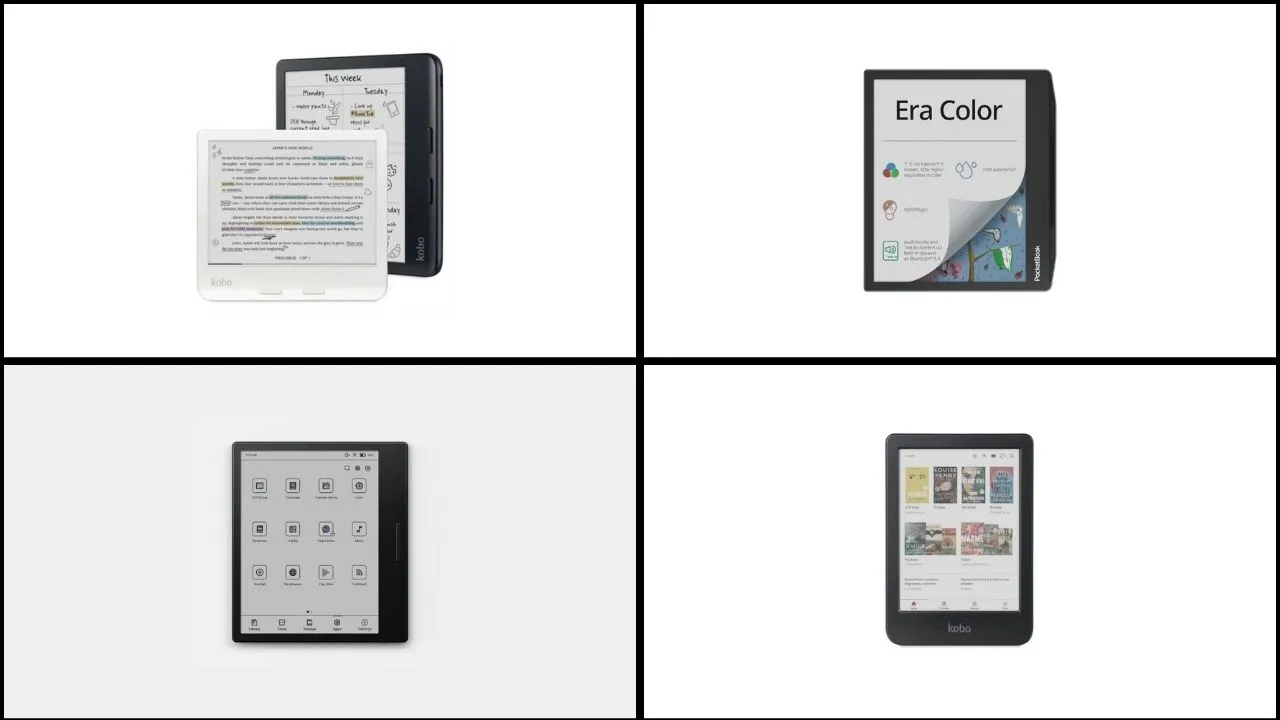
Leave a Reply